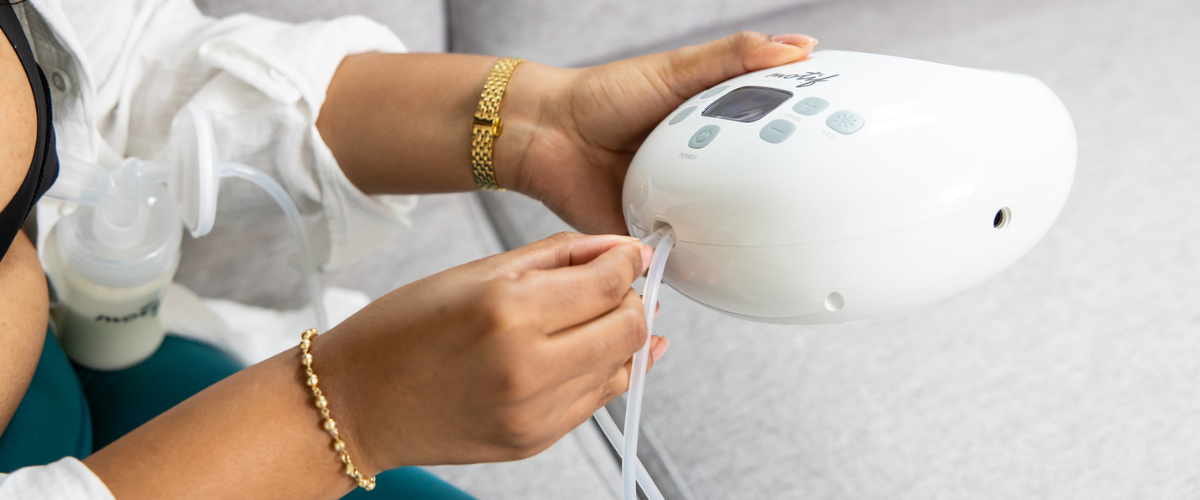Pumping With Breastmilk Collection Cups
You’ve received your Motif Breastmilk Collection Cups and are ready to rule the world now that you can pump hands-free, but did you know there are some key steps to maintaining your cups for optimal function? With these tips, you’ll be set up for hands-free pumping success for the remainder of your breastfeeding journey.
Cleaning Your Collection Cups
The same CDC guidelines1 that apply to cleaning traditional pump flanges and parts also apply to cleaning Breastmilk Collection Cups. Let's go over these steps together!
Before First Use
Clean Your Collection Cups: Wash all components of your collection cups, except the tubing.
Sanitize for Extra Protection: Use Motif Micro Steam Sterilizer Bags or place Collection Cup components in boiling water for no more than five minutes. *Tubing does not require sanitization and should not be submerged in water.
Before Each Use
Ensure Your Pumping Surface Is Clean: A clean pumping surface reduces the risk of contaminating mom's breastmilk.
Wash Your Hands: It’s important to thoroughly wash your hands with soap and water for at least 20 seconds to avoid contaminating your breastmilk.
Assemble Clean Collection Cups: Start by inserting the silicone duckbill valve into the breast shield, then add the diaphragm. Be sure the diaphragm is fully seated around the edge. Use the buckle assembly to get a secure seal when adding the cup to the breast shield. You should hear a “click”. Connect the tubing to the Collection Cups and your pump.
This is a great time to inspect your parts for any wear or damage that can impact function.
After Each Use
Store Your Milk Safely: With clean hands, carefully open your Collection Cups and gently pour your milk into a milk storage container or bag. The handy spout reduces the risk of spills. Store your milk in the refrigerator, freezer, or cooler bag with cold packs.
Disassemble Your Collection Cups: Detach the tubing and set aside. Tubing should never be submerged in water. Fully take apart your cups for cleaning. Remove duckbill valves and diaphragms.
Clean All Parts That Come In Contact With Milk: Rinse parts right away, then wash as soon as possible after pumping. Wash parts with hot, soapy water and allow to air dry. When using a separate basin and bottle brush, rinse thoroughly. Consider sanitizing the basin and brush in the dishwasher every few days and allowing it to air dry.
For Extra Protection
Sanitize: Sanitizing is recommended for babies under 2 months old, preterm babies, and babies who have compromised immune systems.
*Tubing does not require sanitization.
- Wash all parts that come into contact with breastmilk before sanitizing.
- Motif Micro Steam Sterilizer Bags make sanitizing easy and convenient. Each bag is good for 20 uses and 7 bags are included in each box, making them quite economical!
- Collection Cups can also be sanitized in boiling water for no more than five minutes. *Never submerge tubing in water!
Store Safely
Once your parts have been cleaned, it’s important to allow them to air dry and store them in a clean, protected area.
- Motif Breast Milk Collection Cups come with a wet/dry storage bag, perfect for keeping them clean and safe between pumping sessions.
- Collection Cups can also be stored and transported in our Breast Pump Backpack. This bag has room for all your pumping and baby care accessories.
The Fridge Hack and Collection Cups
While we know that breastmilk can safely be stored in the refrigerator for at least four days (some experts say eight), there hasn’t been adequate research on the safety of refrigerating breast pump parts between uses.


In 2023, the CDC’s website included recommendations to thoroughly rinse pump parts before storing them in the refrigerator and to only use the fridge hack when washing isn't an option. They also advised against storing parts in the fridge between uses if pumping for a baby under two months old, a baby who was preterm, or a baby with a compromised immune system. They’ve since removed this information, indicating the importance of cleaning pump parts after every use. It’s also important to consider that there isn’t adequate information about how the fridge hack can impact the performance of pump parts due to the possibility of milk fat impacting suction and overall effectiveness. The CDC, among other experts, recommends thoroughly washing parts between pumping sessions.1, 2, 3
When to Replace Parts
To keep your Breastmilk Collection Cups operating optimally, you’ll need to replace the softer silicone components regularly based on how often you’re using them. Worn, warped, torn, or stretched parts can dramatically impact suction. Many insurance plans cover replacement parts! These parts are shipped in a resupply kit which includes everything you need for double pumping. Check with your breast pump provider to see if your replacement parts are covered.
Diaphragms can stretch and warp over time. Replace every 90 days or sooner if they are warped, torn, or discolored.
Duckbill Valves may begin to gap after frequent pumping. Replace every one to three months as needed. Replace sooner if they gap when not in use, are torn, or become discolored.
Silicone Flange Inserts should be replaced when they will no longer stay firmly seated in the flange/breast shields, if they become torn, or if they become discolored.
Breast Shields/Cups are intended to be more durable than the softer silicone components of your Collection Cups. However, they should be replaced if cracked, warped, or discolored.
Tubing should be replaced any time it is not staying easily connected to your pump or your Collection Cups. It should also be replaced if it is torn, punctured, or has become wet inside. Tubing typically needs to be replaced every six months.
Information provided in blogs should not be used as a substitute for medical care or consultation.










